Going solo
Abstract
As Soft Matter takes its first few steps as an independent publication, Katie Gibb, Commissioning Editor, Carol Stanier, Editor, and Ulli Steiner, Chairman of the Board, reflect on some key events from last year and look forward to the exciting new developments for Soft Matter and the RSC in 2007.
2006 was a phenomenal year for Soft Matter. In June the journal celebrated its first birthday with free access for all and received its first ISI® citation measure, placing the journal clearly ahead of its competitors. Shortly afterwards we announced that due to its tremendous success, Soft Matter would soon become an independent publication (see Fig. 1).
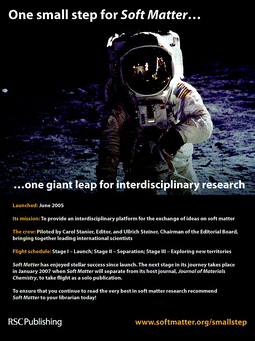 | ||
| Fig. 1 Advert from 2006 announcing the separation of Soft Matter from its host Journal of Materials Chemistry. | ||
And now it's official, Soft Matter has separated from its host journal, Journal of Materials Chemistry, and is now a fully fledged solo publication. Its availability since launch to readers of Journal of Materials Chemistry and the online hosts, Physical Chemistry Chemical Physics, Organic & Biomolecular Chemistry and Lab on a Chip, has ensured that Soft Matter received a large and interdisciplinary audience from the outset. Readers of these journals wishing to continue to read Soft Matter now need to recommend the journal to their librarian. Fill in the online recommendation form at www.rsc.org/libraryrecommendation
We'd like to extend a big thank you to all our authors, readers and referees for their support of the journal since its launch. Soft Matter was created as the answer to the needs of your community, the call for an interdisciplinary platform where physicists, biologists, materials scientists, engineers and chemists could communicate their research. We hope that you will continue to enjoy reading Soft Matter and send us your best papers in bulk soft matter assemblies, soft nanotechnology and self-assembly, biological aspects of soft matter, surfaces, interfaces and interactions, synthetic methodology, theory, modelling and simulation.
We are always happy to receive feedback from authors, especially if it helps us to further improve the publishing experience. Because we believe that RSC Publishing offers the best service of any scientific publisher, we have published a selection of the comments we have received from authors from around the globe—take a look at www.rsc.org/authorquotes
Rising to the top
Although Soft Matter is too young to have an impact factor, the 2005 ISI® citation data (released in June 2006) placed the journal clearly ahead of its competitors with an impressive immediacy index of 1.022 (see Fig. 2). The immediacy index measures how topical and urgent papers published in a journal are, by dividing the number of citations in a given year by the number of articles published in the journal that year. “In addition to this recognised metric, I can see from the quality of the authors publishing that Soft Matter is already attracting some of the best people in the field,” says Geoff Maitland, Imperial College, UK.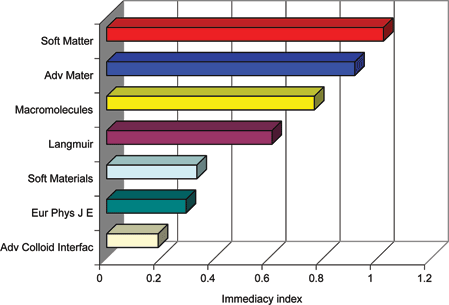 | ||
| Fig. 2 2005 immediacy indices for Soft Matter and related journals (from ISI® citation data, released June 2006). | ||
Last year also saw an impressive average increase of over 10% for RSC journal impact factors.† These striking new figures reinforce the RSC's reputation as the home of exciting new research.
Global appeal
Publishing in Soft Matter ensures that your research will have global visibility (see Fig. 3). Authors from North America are encouraged to submit manuscripts to our North American Associate Editor, Darrin Pochan (see Fig. 4), via our website at www.rsc.org/ReSourCe—simply choose the Soft MatterDelaware Office. Darrin will then handle your manuscript from submission through the peer review process. You can read more about Darrin's thoughts on this role for Soft Matter on our website at http://www.softmatter.org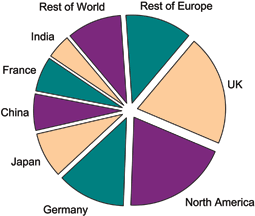 | ||
| Fig. 3 Soft Matter received submissions from all over the world in 2006 (data correct to November 2006). | ||
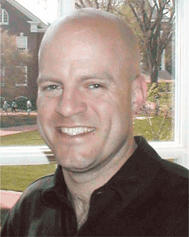 | ||
| Fig. 4 Professor Darrin Pochan in the Soft Matter North American Editorial Office. | ||
In the press
Soft Matter articles are often showcased in the RSC news supplements Chemical Science, Chemical Technology, and Chemical Biology, as well as on the journal website. Other RSC journal articles appearing in these supplements that are of interest to the Soft Matter audience will also be brought to you on our website this year.The news supplements have proved very popular with readers and authors alike. In fact, the supplements have become so successful that from January 2007, all issues will be eight pages (in print), contain new article types and come complete with a fresh new look for the front page. Supplementary material will also be available online.
Meanwhile Chemistry World, the RSC's award-winning magazine, launched two new web features at the end of 2006. The Chemistry World Blog is an interactive forum for news, discussion and opinion, looking at the science hitting the headlines. The Chemistry World Podcast interviews high profile scientists about the latest and hottest topics in science, and is free to download at www.rsc.org/chemistryworld
The spice of life
Papers published in Soft Matter are guaranteed to reach a wide and truly interdisciplinary audience. Our most cited papers from 2006 are on bioinspired colloidal systems (A. S. Angelatos, K. Katagiri and F. Caruso, Soft Matter, 2006, 2, 18) and on the interactions between deformable capsules (A. Alexeev, R. Verberg and A. C. Balazs, Soft Matter, 2006, 2, 499).
Soft Matter has also featured content as diverse as the rheology of chocolate (Y. W. Chen and M. R. Mackley, Soft Matter, 2006, 2, 304) and soft matter with hard skin (J. Genzer and J. Groenewold, Soft Matter, 2006, 2, 310).
Another interdisciplinary topic featured in Soft Matter is of course soft nanotechnology. Recent publications in this area include nanomaterials for restoration of cultural heritage (P. Baglioni and R. Giorgi, Soft Matter, 2006, 2, 293) and engineering the nanoparticle–biomacromolecule interface (C.-C. You, A. Verma and V. M. Rotello, Soft Matter, 2006, 2, 190).
But it is not just Soft Matter that is publishing high-quality papers on nanotechnology—due to the interdisciplinary nature of the subject other RSC journals and books also include related content. This wealth of nano material has now been brought together on one convenient webpage, which is regularly updated with the latest research and books from RSC Publishing. Visit: www.rsc.org/publishing/journals/nanoscience/
Unlocking science
Authors publishing in RSC journals now have the option of paying a fee in exchange for making their accepted communication, research paper or review article openly available to all via the web, with RSC Open Science. The scheme is only made available to authors once their papers have been accepted for publication, following the normal rigorous peer review procedures (RSC Open Science operates in parallel with the normal publication route, which remains free to authors). Authors who have published their work in RSC journals are also able to retrospectively apply for their work to be included in the scheme. Further information can be found at: www.rsc.org/openscienceNot just journals…
As well as an impressive portfolio of prestigious journals, the RSC has a wide selection of products for anyone with an interest in the chemical sciences. Visit the shop at www.rsc.org/shop to browse over 400 book titles, subscribe to or purchase an individual article from Soft Matter or any other RSC journal, join the RSC or renew membership, or register to attend a conference or training event.In addition, RSC Publishing is pleased to announce the launch of the RSC eBook Collection. RSC books are now available online and can be easily downloaded as either chapters or books. The collection is fully searchable and also integrated with RSC journal content. To search the collection or for further information, visit www.rsc.org/ebooks
Forward thinking
2006 has seen RSC Publishing invest significantly in technological developments across all of its products. Introduced last year, RSS feeds, or ‘really simple syndication’, have proved extremely popular with our readers. Subscribers receive alerts as soon as an Advance Article is published in their journal of choice, providing both the graphical abstract and text from a journal's contents page. You can subscribe via the Soft Matter homepage.Subscribers to Soft Matter will now link from journals' contents lists straight through to the HTML view of selected articles, in just one quick step. Here you can download references to citation managers (such as EndNote, Ref Manager, ProCite and BibTex), sign up for RSS feeds, search for citing articles (otherwise known as ‘forward linking’), print the article with just one click and send the article to a friend or colleague.
Living science
From 2007, authors publishing in RSC journals will see their science “come alive” thanks to an exciting new project pioneered by the RSC. Enhanced HTML in RSC articles will allow chemical and biological compounds mentioned in the text to be identified; by clicking on the compound readers will be able to obtain further information about that compound, including a downloadable structure plus a list of relevant subject areas. The RSC is the first publisher to utilise the International Chemical Identifier (InChI) (a digital equivalent of the IUPAC name for any particular covalent compound where structures are expressed in terms of five layers of information—connectivity, tautomeric, isotopic, stereochemical, and electronic) for a project of this type and scope. The technology will be used to enhance RSS alerts so that future news feeds can include chemical structures and other enhanced information. RSC Publishing intends to evolve this project to match author and reader needs so tell us what you think: we welcome your feedback on this new functionality and will incorporate your ideas to develop the service further. Find out more at www.rsc.org/sciencecomealiveThese developments demonstrate the investment in publishing products and services over the past year and 2007 will see us enhancing our products further.
The road ahead
The future for Soft Matter will certainly be exciting as we make our first solo expedition as an independent interdisciplinary journal. Issue 3, 2007 will showcase Soft Matter's first theme issue, guest edited by Professor Joachim Spatz (MPI Stuttgart and University of Heidelberg, Germany). The issue will focus on Proteins and Cells and Functional Interfaces, and include top research from Ulrich Schwarz, Viola Vogel, and Dennis Discher (see Fig. 5).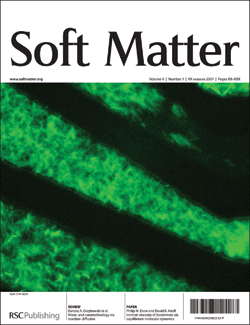 | ||
| Fig. 5 Outside cover of theme issue on Proteins and Cells at Functional Interfaces, Soft Matter Issue 3, 2007 (image by Nicholas Melosh, Matthew Footer and Ian Wong). | ||
And there are many other new features we will be offering to our authors and readers. Why not come and meet us at one of the many conferences we will be attending over the year to find out more? You can plan your meeting attendance using our stunning free Soft Matter year planner (Fig. 6), available electronically from our website http://www.softmatter.org or in print at our conference stand.
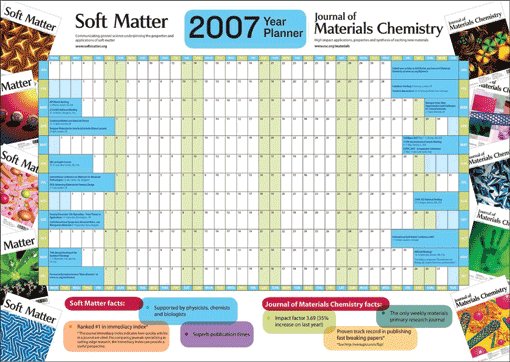 | ||
| Fig. 6 Soft Matter 2007 year planner. | ||
Finally we'd like to thank the Editorial Board and International Advisory Editorial Board for all their support, ideas and encouragement since the journal was launched. We are all looking forward to another exciting year here at Soft Matter.
Commissioning Editor, Soft Matter
Editor, Soft Matter
Chair, Soft Matter Editorial Board
Footnote |
| † Calculated annually, ISI® impact factors provide an indication of the quality of a journal—they take into account the number of citations in a given year for all the citeable documents published within a journal in the preceding two years. |
| This journal is © The Royal Society of Chemistry 2007 |




